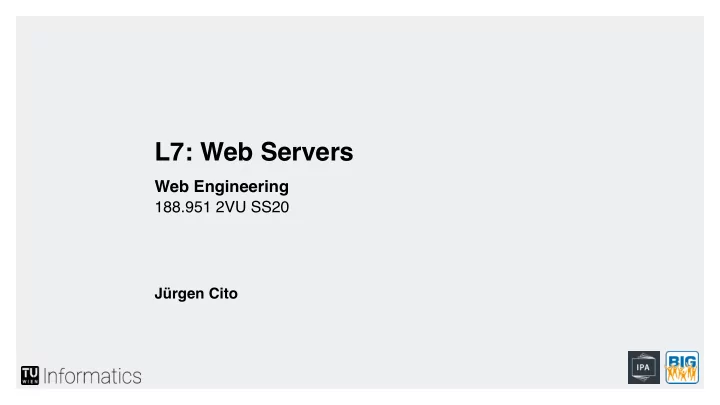

L7: Web Servers Web Engineering 188.951 2VU SS20 Jürgen Cito
L7: Webservers • Overview of web servers (hardware and server software) • Web servers as part of internet architecture • Serving static resources over the filesystem • Dynamic resources through server-side scripting and HTTP
Learning Goals • Understand the difference between web servers as hardware and software • Place web servers on the map of broader scale of internet architecture • Describe static and dynamic resources with respect to web servers and HTTP • Ability to write a basic web server with JavaScript/Node.js
Recap: High Level Web Overview - Servers wait for requests - They serve web resources Client Server www.google.at —> 172.217.23.227 172.217.23.227 HTTP Domain Name Browser (Hyper Text Transfer System (DNS): Protocol) Translating hostname to IP HTTP Request address HTTP Response Other Server HTTP Request HTTP Response Devices Multiple layers and proxies Proxies on the internet Icons by the Noun Project: Cattaleeya Thongsriphong, Flatart, Graphic Tigers, I Putu Kharismayadi
Web Server Web Server HTTP “Web Server” is an ambiguous term: (Hyper Text Transfer Protocol) 1. Hardware: A computer (“server”) HTTP Request connected to the internet (or any network) HTTP Response 2. Software : A program running on a HTTP Request computer/server that accepts HTTP HTTP Response requests over a specific port and answers with HTTP responses Icons by the Noun Project: Cattaleeya Thongsriphong, Flatart, Graphic Tigers, I Putu Kharismayadi
Web Server - Hardware Hardware: A computer (“server”) connected to the internet (or any network) Properties of contemporary web servers ▪ Part of large data centres ▪ Latency is geographically dependent, so web servers are often geographically distributed (works through, e.g., DNS) ▪ Virtual servers: Physical servers can host many virtualized (web) servers Can also be your own computer (localhost) “Data Center” by Sean Ellis https://flic.kr/p/6UDnWP
Web Server - Geo DNS Geo-location based Serving through DNS: Serving resources from geographically closer data centres DNS: {Hostname, “Location”} —> IP LDNS = “Local” DNS provided by the ISP If not present in LDNS, contacts global DNS. They determine IP address to be returned based on policies regarding “location” features (e.g., IP address) https://docs.microsoft.com/en-us/windows-server/networking/dns/deploy/primary-geo-location
Web Server - Virtual Servers and Containers One physical server can host multiple virtual servers and/or containers Virtual Machines ▪ Enables multiple virtual instances of different operating systems to run in isolation through technology called “hypervisor” ▪ Hypervisors divide physical resources so that virtual servers can use them and “translates” kernel operations Containers https://www.redhat.com/en/topics/virtualization ▪ Containers “feel” like virtual machines, but are not virtualized ▪ They provide lightweight process isolation (through cgroups) but share the Host OS kernel ▪ Beware that containers do not offer the same security boundaries
Web Server - Cloud The “cloud” enables provisioning of computational resources over an API Infrastructure as a service (IaaS) ▪ API-driven infrastructure (web servers) at scale ▪ Provides the ability to write a script that automates retrieving new (virtual) server capacity ▪ Examples: AWS EC2, Google Compute Engine, … Platform as a Service (PaaS) ▪ Managed application runtimes (e.g., web servers) that are built on top of IaaS for scalability ▪ Underlying infrastructure (server) is abstracted away, configuration can provide directives ▪ Example: Heroku, CloudFoundry, App Engine ▪ Deploy web applications by providing directives on process to start or providing container Jürgen Cito, Philipp Leitner, Thomas Fritz, and Harald C. Gall. 2015. The making of cloud applications: an empirical study on software development for the cloud . In Foundations of Software Engineering (FSE 2015)
Web Server - Software Web Server Software : A program running on a computer/server that accepts HTTP requests over a specific port and answers with HTTP responses Web Server/HTTP Server ▪ Makes resources accessible over a URL and HTTP/S (standard ports 80 and 433) ▪ Starting a web server on local computer makes it accessible over ▪ http://localhost ▪ http://127.0.0.1 ▪ Maps path component of URL to https://localhost:3000 /members/rackets ?year=2020 ▪ static asset on the file server Path component + query parameters ▪ dynamically rendered resources ▪ Often incorporates some functionality for caching and session handling
Web Server - Static Assets Serving static assets from the file system ▪ Web server automatically wraps static Example: files with HTTP Response Headers ▪ Static assets made available at path ▪ Static assets directly map URL path to /var/www/public_html relative part of the file system on the server ▪ They cannot react to other part of the request (e.g., query parameter) ▪ If we determine [this is configurable] ▪ MIME-Type is inferred through heuristics (e.g., file endings) http://localhost/static/js/search .js ▪ Example of common static files in web servers to be a request for static assets we ▪ HTML, CSS could return /var/www/public_html/js/search.js ▪ JavaScript (for use in browser) ▪ Media (Images, Video, Audio, etc.)
Web Server - Dynamic Resources Dynamic Resources ▪ Executing programs in a server side programming language on the server ▪ Dynamic resources can react to complete HTTP request (including header information) ▪ Path and Query Parameters ▪ HTTP Method (GET, POST, PUT, … ) ▪ Content Negotiation ( Accept: application/json ) ▪ … ▪ System output is treated as the complete HTTP response (including headers) ▪ However, many programming languages offer library support for basic HTTP related functions and provide abstractions (e.g., for dealing with response headers)
Web Server - Examples Apache/httpd with CGI (Common Gateway Interface) ▪ One of the earliest methods of providing dynamic scripting ▪ Live Example: https://github.com/web-engineering-tuwien/docker-cgi-python nginx ▪ Reverse proxy and web server ▪ Online Tutorial: https://www.digitalocean.com/community/tutorials/how-to-configure- nginx-as-a-web-server-and-reverse-proxy-for-apache-on-one-ubuntu-18-04-server Node.js Web Server const http = require('http'); const requestListener = function (req, res) { res.writeHead(200); res.end('Hello, World!'); } const server = http.createServer(requestListener); server.listen(8080);
Recommend
More recommend